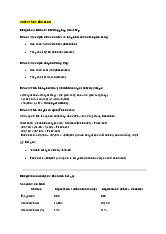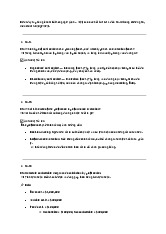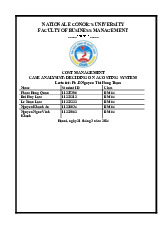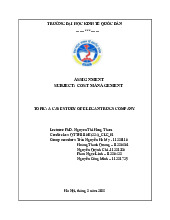











Preview text:
lOMoAR cPSD| 58511332
NATIONAL ECONOICS UNIVERSITY
FACULTY OF BUSINESS MANAGEMENT _____ _____ COST MANAGEMENT
CASE ANALYSIST: DECIDING ON A COSTING SYSTEM
Lecturer: Ph.D Nguyen Thi Hong Tham Name Student ID Class Pham Hong Quan 11225396 BM 64 Bui Huy Lam 11223212 BM 64 Le Xuan Lam 11223222 BM 64 Nguyen Khanh An 11220034 BM 64 Nguyen Ngoc Vinh 11223062 BM 64 Khanh
Hanoi, ngày 21 tháng 3 năm 2024 lOMoAR cPSD| 58511332 Contents
A. What type of costing system, job-order or process, is most appropriate
for the commodity products and
why?.......................................................5
B. What type of costing system, job-order or process, is most appropriate
for the differentiated products and why?...................................................6
C. If you recommended different costing systems for the different types of
products, what problems do you foresee in using two costing systems?.......7
D. Should Joan use actual or normal costing to assign overhead costs to
commodity products? To differentiated products? Is this decision affected
by the decisions about job-or-der and process costing? Explain your
answers.....................................................................................................8
E. What problem do you see with Joe's response to Joan's question about
the need for accuracy in unit costs? How should Joan respond to Joe?.....10 lOMoAR cPSD| 58511332
Lux Electronics is completing a new plant that will begin manufacturing circuit
boards within six months. Joan Keyes has just been appointed plant controller and must
decide what type of cost accounting system the plant will use. The plant will
manufacture many different models of two basic types of circuit boards: made-
forinventory boards and made-to-order boards.
In discussions with marketing and production managers, Joan learns that all
models of the made-for-inventory circuit boards are commodity products, similar in
design and requiring nearly identical materials, labor, and time in production. The
commodity boards are made in very large batches that require long production periods.
It is expected that a typical batch of commodity boards will take over a week to
manufacture and result in tens of thousands of boards. Batches of commodity boards
will be produced on a continuous basis.
The various models of made-to-order boards, on the other hand, are differentiated
prod-ucts. Each model is custom designed, and different models require modifications
to the production process and times to manufacture. Differentiated models also require
very different materials and varying amounts of labor. Differentiated boards will be
manufactured sporadically in small batches of only a few hundred boards.
The two basic types of boards will be made using separate production lines
within the same plant facility. Manufacturing overhead will comprise about 60% of the
total manufacturing cost. Direct labor, direct materials, most indirect materials, line
supervision, equipment costs, and some electrical costs can be traced directly to one of
the two lines. Other manufacturing costs, such as those associated with plant
supervision, personnel department, cafe-teria, and plant office, are common to both
lines. Some indirect labor will be shared by both types of boards. Further, some plant
overhead costs, such as the cost of heating and air conditioning the plant, are difficult
to assign except on some basis such as the amount of square footage occupied by each line.
Lux management expects that the commodity products will compete mainly on
cost with low profit margins and will be priced based upon established market prices. lOMoAR cPSD| 58511332
Company management is therefore very concerned that the costing system accurately
reflect the costof manufacturing for these products. If commodity product costs are not
reasonably accu-rate, Lux may experience poor cost control and lose money on these products.
Conversely, the differentiated models generally will be priced at cost plus a
percentage markup over cost. Company management is therefore concerned that
inaccurate product costing will lead to low profit margins if the boards are priced too
low or lost sales if the boards are priced too high.
While gathering information before deciding on a costing system, Joan recently
sent an e-mail message to Lux's assistant vice president in charge of marketing the new
circuit boards, Joe Bally, asking how accurate the unit costs of the boards need to be.
Joan is troubled by Joe's response to her question: "I have always assumed that unit
costs are accurate to the nearest penny. Why would that not be the case? That's the way you accountants report them."
Joan is eager to get off on the right foot with the other managers involved with
the new plant's operations and those engaged in marketing the products it will make.
She knows that an inaccurate costing system can lead to poor operating performance.
She is concerned that the wrong decisions now will lead to serious problems later.
A. What type of costing system, job-order or process, is most appropriate for the commodity products and why?
B. What type of costing system, job-order or process, is most appropriate for the
differentiated products and why?
C. If you recommended different costing systems for the different types of
products, what problems do you foresee in using two costing systems?
D. Should Joan use actual or normal costing to assign overhead costs to
commodity products? To differentiated products? Is this decision affected by
the decisions about job-or-der and process costing? Explain your answers.
E. What problem do you see with Joe's response to Joan's question about the need
for accuracy in unit costs? How should Joan respond to Joe? lOMoAR cPSD| 58511332 Le Xuan Lam A.
What type of costing system, job-order or process, is most appropriate for
the commodity products and why?
For the commodity products (warehouse-made circuit boards) produced by Lux
Electronics, the most appropriate costing system would be the process costing system:
● Homogeneous Production: The commodity circuit boards are similar in
design and require nearly the same materials and labor. They are produced in
large batches continuously. Process costing is well-suited for products that
undergo a continuous production process with little variation in design or
production methods. This system allocates costs to each unit based on the
average cost of producing all units in a given period, aligning with the
continuous and repetitive nature of production for commodity products.
● Cost Accumulation: Process costing allows for the accumulation of costs over
a period, making it suitable for large-scale production of homogeneous
products like commodity circuit boards. Costs such as direct materials, direct
labor, and overheads can be accumulated and allocated to each unit based on
the total cost incurred during the production period.
● Uniform Costing: Process costing ensures uniformity in the cost calculation
for each unit of the commodity product. Since all units undergo similar
production processes and use similar resources, averaging the costs over the
entire production run provides a fair representation of the cost per unit. This
uniform costing approach is important for commodity products that compete primarily on cost.
● Management Focus on Cost Control: Lux's management expects commodity
products to compete primarily on cost with low margins. Process costing
provides a detailed breakdown of production costs, enabling management to
closely monitor and control costs. Accurate cost information is crucial for
effective cost management and ensuring competitiveness in the market.
● Ease of Implementation: Process costing is relatively straightforward to
implement, especially in environments where production processes are
continuous and standardized. It allows for efficient cost allocation without the
need for individual tracking of costs for each unit, which can be cumbersome
for large-scale production operations.
Overall, the process costing system is the most appropriate choice for Lux Electronics'
commodity products due to their homogeneous nature, continuous production process,
and the need for accurate cost control to maintain competitiveness in the market. lOMoAR cPSD| 58511332 Bui Huy Lam B.
What type of costing system, job-order or process, is most appropriate for
the differentiated products and why?
- Based on the information about the differentiated products and their production
requirements, a job-order costing system is most suitable for these products: 1.
Characteristics of Differentiated Products: Differentiated circuit board
models require customization and modifications during production. Each product
model has unique designs, materials, and labor requirements. This diversity in
production necessitates the tracking of costs for each specific order. 2.
Cost Specificity: Utilizing a job-order costing system allows Joan to
accurately track the specific costs associated with each production order. Costs such
as materials, labor, and indirect costs can be identified and allocated to individual orders. 3.
Cost Determination for Pricing: The pricing of differentiated products is
often based on production costs plus a desired profit margin. A job-order costing
system provides precise cost information for reasonable pricing decisions that ensure adequate profitability. 4.
Cost Management: A job-order costing system provides detailed cost
information for each order, aiding Joan and other managers in effective cost
monitoring and management, especially for products with such unique characteristics.
Therefore, employing a job-order costing system will help Lux Electronics effectively
manage costs and price-differentiated products accurately and efficiently. Nguyen Khanh An
C. If you recommended different costing systems for the different types of
products, what problems do you foresee in using two costing systems? lOMoAR cPSD| 58511332
Implementing different pricing systems for different product types can indeed present some challenges:
1, Complexity in Costing: Managing two separate pricing systems adds complexity to
the overall accounting process. It requires meticulous tracking of costs associated with
each product type, including direct materials, direct labor, and overhead costs.
2, Accuracy of Cost Allocation: Allocating indirect costs to each product type
accurately becomes more challenging when using two pricing systems. There's a risk
of misallocation, especially for shared resources and overhead costs.
3, Difficulty in Cost Control: With separate pricing systems, it's more challenging to
control costs effectively across both product types. The focus on accurate costing for
commodity products might lead to neglect in controlling costs for differentiated products, and vice versa.
4, Potential for Errors and Inconsistencies: Maintaining separate pricing systems
increases the likelihood of errors and inconsistencies in cost calculations and pricing
decisions. This can result in inaccurate financial reporting and decision-making.
5, Customer Perception and Pricing Strategy: Customers may perceive inconsistency
in pricing strategies, which could impact their trust in the company. Moreover,
managing different pricing strategies for different product types requires a clear
communication strategy to avoid confusion among customers.
6, Operational Challenges: Implementing different pricing systems may require
adjustments to operational processes, such as inventory management, production
scheduling, and sales forecasting. It may also necessitate additional training for
employees involved in these processes.
7, Strategic Alignment: Ensuring that both pricing systems align with the overall
strategic goals of the company can be challenging. There should be coherence lOMoAR cPSD| 58511332
between pricing strategies and the company's objectives, such as profitability, market
positioning, and customer satisfaction.
To mitigate these challenges, Joan Keyes should work closely with relevant
stakeholders, including marketing, production, and finance departments, to develop a
comprehensive pricing and costing strategy that addresses the specific needs of each
product type while maintaining overall coherence and accuracy in financial reporting.
Additionally, leveraging advanced cost accounting techniques and software solutions
can help streamline the process and improve accuracy in cost allocation and pricing decisions. Pham Hong Quan D.
Should Joan use actual or normal costing to assign overhead costs to
commodity products? To differentiated products? Is this decision affected by the
decisions about job-or-der and process costing? Explain your answers.
Joan's decision between job order costing and process costing affects the decision of
whether to use actual costing or standard costing for overhead costs. The following is an analysis: Commodity Products:
Process Costing with Normal Costing: Given that commodity products are commonly
manufactured in large quantities using comparable procedures, process costing
emerges as the most appropriate approach. Normal costing is a suitable approach for
process costing due to its utilization of pre-established overhead rates. This approach
streamlines the allocation procedure for substantial quantities of commodity goods.
● Benefits of Normal Costing:
○ Simplicity: Standard costing eliminates the necessity of waiting for
precise overhead data, hence simplifying management. lOMoAR cPSD| 58511332
○ Timely Decisions: The utilization of predetermined rates facilitates
expedited cost predictions, a critical factor in the determination of
pricing and manufacturing strategies for commodity goods.
Differentiated Products:
● Job Order Costing with Flexibility: Job order costing is the recommended
method for differentiated products that possess distinct production
requirements. Nevertheless, the decision between actual costing and standard
costing gets increasingly intricate.
● Normal Costing as a Baseline: Standard costing provides a straightforward
approach and might serve as a suitable initial reference. It offers a uniform
overhead rate for every task, making it easier to estimate and compare.
● Actual Costing for High Accuracy: Actual costing might be advantageous when
accurate cost information for each distinct product is crucial. It accurately
represents the real expenses associated with each individual task, resulting in
more precise cost information. Nevertheless, this entails the additional intricacy
of monitoring and distributing real overhead expenses.
Impact of Costing Systems:
The selection between job order and process costing has a substantial impact on the
determination of whether to use actual or normal costing.
● Process Costing: When employing process costing, which is particularly
suitable for commodity products, normal costing emerges as the evident
preference owing to its straightforwardness and seamless integration.
● Job Order Costing: When employing task order costing, which is particularly
suitable for differentiated items, the decision-making process becomes more intricate.
○ Normal Costing: While simpler to execute, it may result in less precise
cost data for certain tasks with diverse overhead requirements.
○ Actual Costing: This is more precise for certain tasks but necessitates a more intricate price scheme. Conclusion: lOMoAR cPSD| 58511332
● Normal Costing as Foundation: Normal costing is commonly recommended for
both commodity and differentiated products due to its simplicity and capacity to offer fast approximations.
● Differentiated Products with Nuance: When dealing with diversified products,
it is advisable to use real costing if achieving high-cost accuracy is of utmost
importance and the added complexity of handling actual overhead expenses is not justified.
In the context of Joan's specific requirements and the chosen costing system (job order
or process) for differentiated products, it is imperative for her to thoroughly evaluate
the trade-offs between simplicity (normal costing) and accuracy (real costing). Nguyen Ngoc Vinh Khanh E.
What problem do you see with Joe's response to Joan's question about the
need for accuracy in unit costs? How should Joan respond to Joe?
The problem with Joe's response to Joan's question about the need for accuracy in unit
costs lies in the assumption that unit costs always need to be precise to the nearest
penny. While precision is important in cost accounting, overly precise unit costs can
lead to inefficiencies and misallocations, particularly in a manufacturing environment
with both commodity and differentiated products.
Joan should respond to Joe by explaining the nuances of cost accounting in their
specific manufacturing context:
1. Differentiated Products:
· These products are custom-designed and vary significantly in terms of materials,
labor, and production processes.
· Since differentiated products are priced based on cost plus a markup, accurate
unit costs are critical to ensuring profitability and competitiveness in the market. lOMoAR cPSD| 58511332
· Inaccurate pricing for these products could lead to pricing decisions that result in
either lower-than-desired profit margins or lost sales due to overpricing.
· Therefore, the cost accounting system should meticulously capture all relevant
costs associated with manufacturing each model of differentiated boards, including
direct materials, direct labor, and specific overhead costs attributed to each model. 2. Commodity Products:
· Commodity boards are standardized products with minimal variation in design and production processes.
· These products compete mainly on cost, have low-profit margins, and are priced
based on established market prices.
· While accuracy is still important, precision to the nearest penny may not be
practical or necessary for commodity products.
· The focus should be on accurately capturing the overall cost structure and
ensuring that cost estimates reflect the true cost drivers.
· However, it's crucial to have a reliable cost accounting system to maintain cost
control and avoid losses, even if small variations in unit costs might not significantly impact pricing decisions.
3. Balancing Precision and Practicality:
· Striking a balance between precision and practicality is essential in cost accounting.
· Excessive precision can lead to unnecessary complexity and may not always
provide proportional benefits, especially for commodity products.
· The cost accounting system should aim to provide managers with relevant and
actionable information without overburdening the process with excessive detail. lOMoAR cPSD| 58511332
4. Overall Performance:
· The primary goal of the costing system is to support overall operational
performance and strategic decision-making.
· It should provide managers with accurate and relevant information to make
informed decisions about pricing, production planning, and resource allocation.
· By tailoring the costing system to the specific needs and characteristics of Lux
Electronics' manufacturing operations, Joan can ensure it provides meaningful insights
for decision-making while avoiding unnecessary complexity.
In summary, while accuracy in unit costs is important, the level of precision required
may vary depending on the type of product and its impact on pricing and profitability.
The cost accounting system should be designed to strike a balance between precision
and practicality, providing managers with the information they need to make informed
decisions while avoiding unnecessary complexity.




